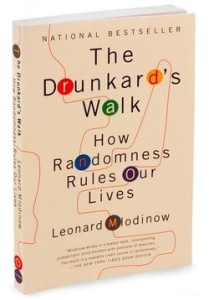 This article was originally published on October 29th 2009. Randomness, especially in our daily lives, is still enthralling to me – I’m working on a new book entitled Manufacturing Luck.
This article was originally published on October 29th 2009. Randomness, especially in our daily lives, is still enthralling to me – I’m working on a new book entitled Manufacturing Luck.
Reading a book on the history and development of probability theory might not seem too enthralling. But somehow Leonard Mlodinow’s The Drunkard’s Walk combines both the technical developments and the characters along the way into a coherent (and enjoyable) whole. Along the way, it points out why the ancient Greeks never studied probability and why most of the great thinking on the subject came about because of gambling.
There’s a method to his madness, though, and a purpose behind this story. For Leonard, studying the development of probability theory is invaluable because it educates us on how we interact with randomness in our current times. The evolution of our thinking on probability is a worthwhile topic of investigation because it still affects us in an age where we “should know better.”
Big Thought
Chance and uncertainty influence many of the decisions we make on a daily basis, and because of that, it’s valuable to understand how probability and our ideas around probability have evolved.
Ideas, Implications, Questions
- “The cord that tethers ability to success is both loose and elastic” (pg 216). This idea, which echoes similar theories from such authors as Malcolm Gladwell and Nassim Taleb, is one of the most important and controversial predictions from the examination of uncertainty and probability. It’s controversial because it flies in the face of “common wisdom” that says there is a direct connection between people’s hard work and abilities and the level of success they enjoy. Leonard points out that ability does help, but it’s simply a part of the equation; and there are many other variables – including ones that have a degree of chance.
- This has a profound meaning for business people. If there isn’t a direct relationship between work and results, what can you do to minimize the effects of randomness and uncertainty? Simple: increase activity, or at the very least, keep trying even if you initially fail. For example, a salesperson who is selling a product or service should keep going even if rejected at first. The more that salesperson tries, the more possibilities there are for success. J.K. Rowling didn’t sell her book about a young wizard to the first publishing company – what if she had given up?
- Be careful to not fall prey to the “Law of Small Numbers” (pg 99). It’s too easy to think that we can predict future performance based on a relatively small sample size. Too often we try to create predictive models based on only a few pieces of data. It doesn’t work, so if you only have a small number of results with which you are trying to evaluate performance, find another metric to use.
- Another common mistake that I thought was illuminating was the hot hand fallacy in which there is the “mistaken impression that a random streak is due to extraordinary performance” (pg 178). How often do we give too much credit to something that is in reality, just a piece of randomness disguised as skill or “good luck”? Looking at it in the reverse, how often do we attribute such things as “bad luck” to natural randomness.
Should you read this book?
Probably. If you have any interest at all in probability, you should invest the time. Even if you don’t think about probability much, it’s a fascinating story and a fun read. The times where Leonard pauses from the narrative to take a quick tour of probabilistic logic is unobtrusive and in the end quite satisfying. It won’t stop you from making decisions with a low chance of success, but at least you’ll know why you made them.
